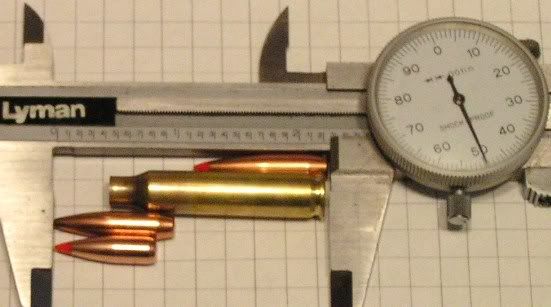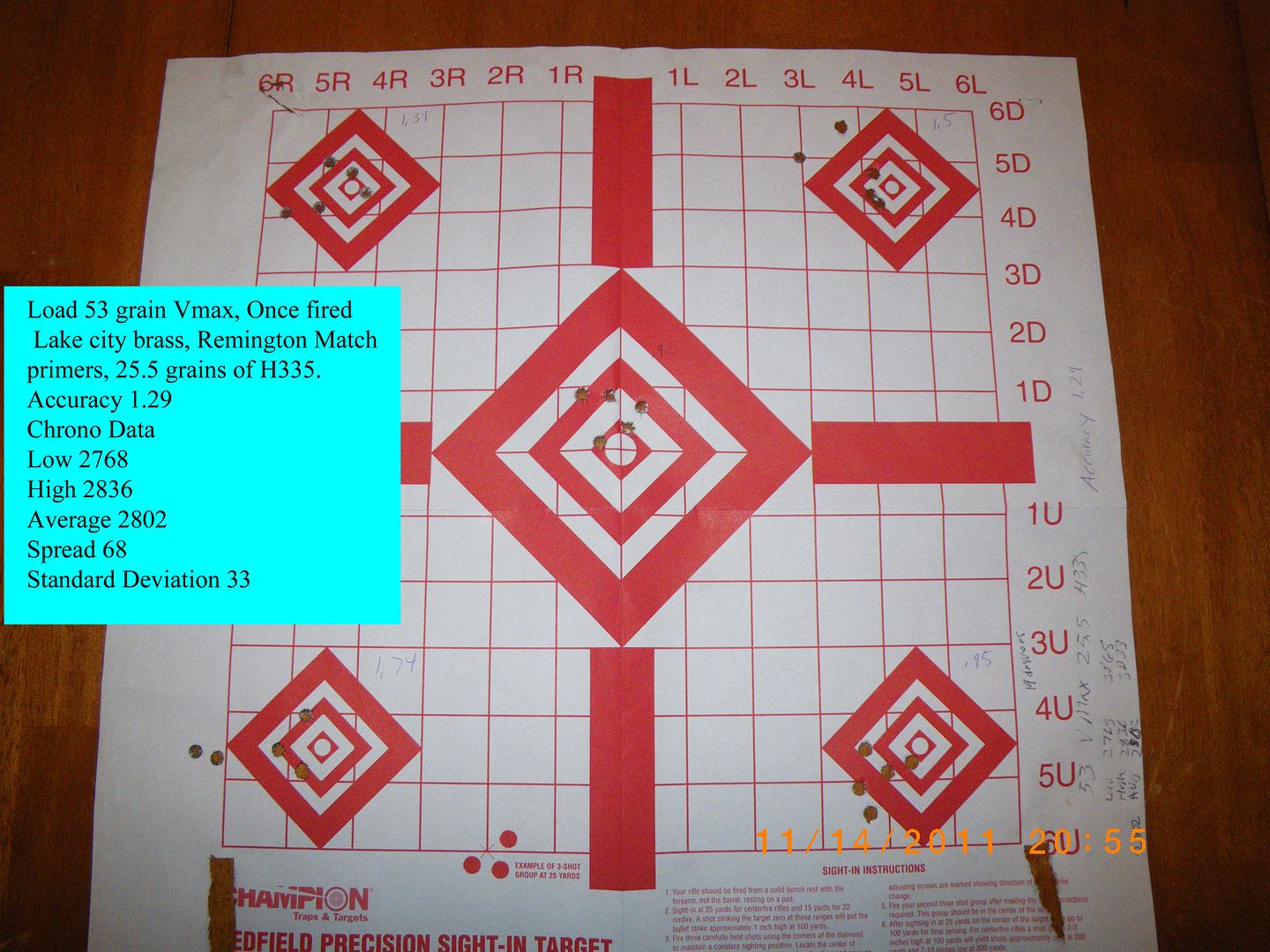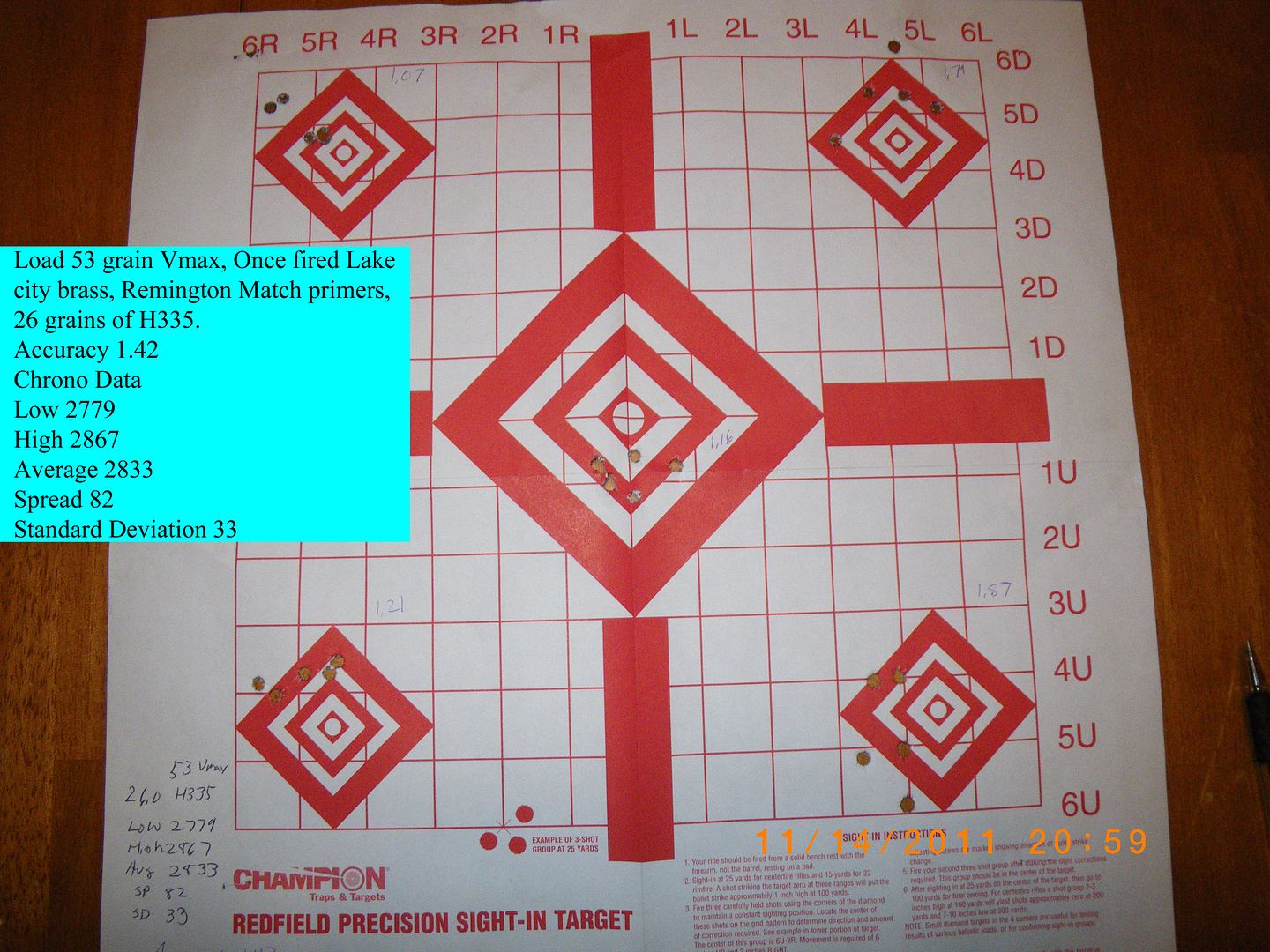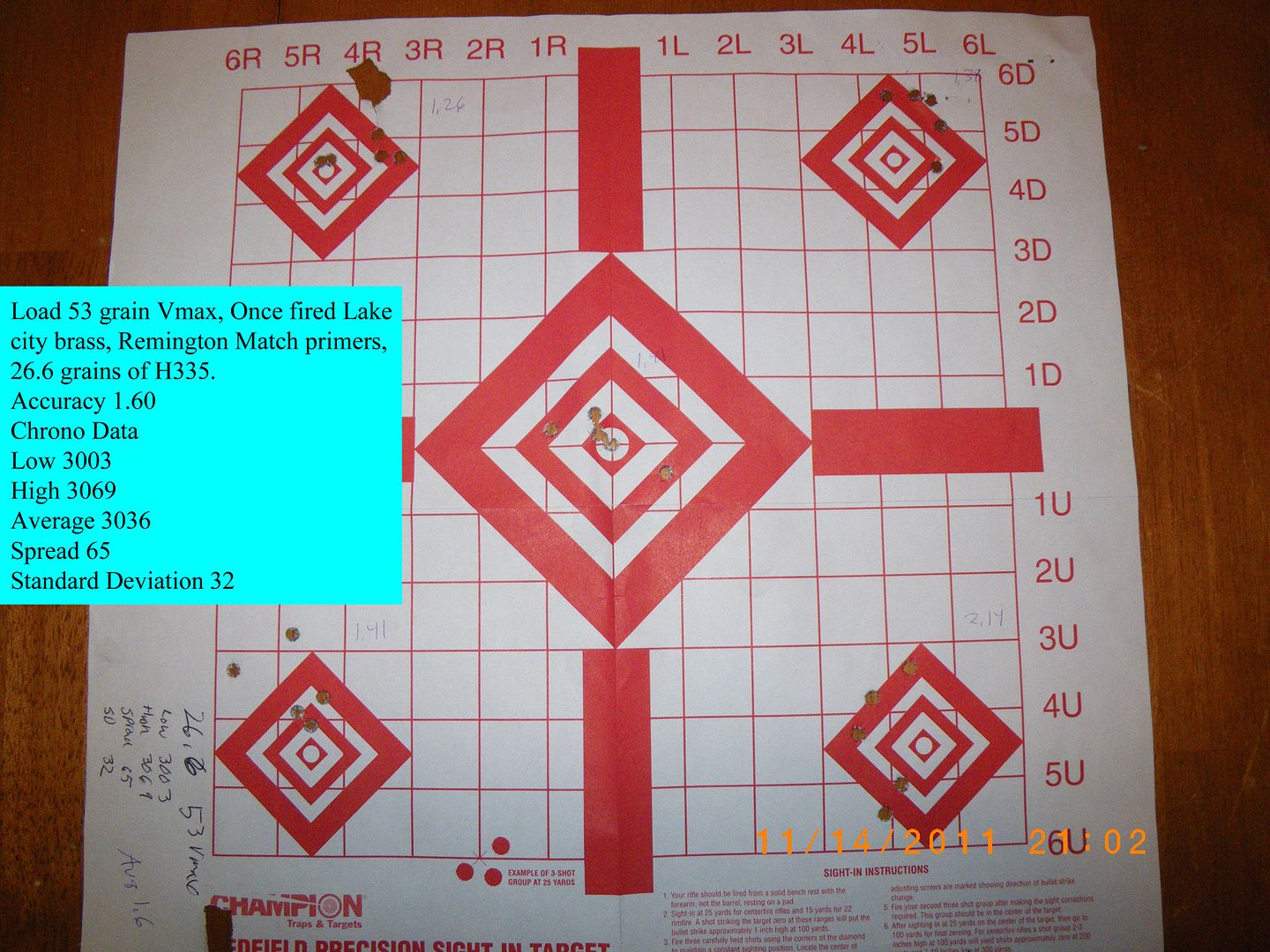Fresh off the UPS truck, 300 Hornady 53 gr. V-max bullets arrived today.
I have been interested in these since I first heard about Hornady making a new bullet that was designed for both shooters with slower than 9 twist rifling (yes a faster twist is ok too) and AR owners , boasting a BC of .290 G1.
I have been patiently waiting to read a user review on some of the online suppliers and/or shooting forums as to whether this bullet lived up to that .290 BC in a light to medium weight package. It just sounded too good to be true, because if it did, it just might be THE go to bullet for 16” barreled .223/5.56 carbines and other short barreled rifles that normally lack the speed to do great things at longer ranges. I have yet to find information proving or disprove the BC, which for me is the selling point on this bullet as it would have a coefficient better than any V-max or similar varmint bullet in the 50gr. to 60gr. class that I am aware of.
Those of us that are varmint hunters and/or target shooters know the wind can play havoc on shots as the distances grow greater. We have had to choose from light bullets shot as blazing speed or if we happen to own a fast twist barrel, to use a longer/heavier and hopefully higher BC bullet to decrease our time of flight and stave off as much wind defection as possible. This issue is only compounded when the rifle we drive has a 16” barrel and the magazine it loads from is restricted to cartridges shorter than 2.26 inches in length. We can use 69, 75 and 77 grain match bullets but they take up valuable powder space and may do little damage on varmints once it arrives four or five hundred yards latter. The V-max line is known for its rapid expansion. This is partly due to the thin jacket design as well as the poly tip that will either break loose reviling a larger surface area or act as a wedge accelerating expansion, the idea being that even if the impact velocity is low we should still see some expansion.
The AR I own sports a chrome lined 16” Sabre Defense 7 twist barrel and shooting a long heavy bullet (75 grain Hornady BTHP as an example) using a temperature insensitive powder I can use year around like Hodgdon’s Varget or IMR 8208. My best performing load tops out at 2530 fps, holds right around moa sized groups and isn’t to taxing on the brass. It handles the wind well enough but drops a little quicker than I’d like. Not a problem if I have time to dial in my drop for the known distance targets at the range but in the field lasering a coyote and dialing in my drop takes up time. One can always use a holdover and guess the distance and that’s all I usually have time for. In that situation the flatter the trajectory the better and this is why/where the speed cartridges like the 22-250 and 243 are a great advantage. But I want to have my cake and it eat it too, in a short and handy carbine.
Find anything interesting here yet???
Some of you are probably either thinking, good grief Jon get on with it all ready
 or your beginning to share my excitement, hopefully the latter.
or your beginning to share my excitement, hopefully the latter.
Well, I am not done testing yet as I have to prove the BC still, however I was able to obtain 2975 out of my AR today. Plus I found some other interesting things out. The bullet is ~.833” long, boat-tailed and shares an ogive angle as best as I can tell closer to an A-max than the V-max’s of old. It looks very promising just from the looks of the design.
I ran a stability model on it and it would appear that at normal 223 speeds (3300 fps) you will need at least an 11 twist barrel or faster. That is unless you have a few thousand feet ASL and warm weather to help you with stability but it would still be a close call.
Left to right; 40 V-Max, 53 V-max, 60 V-max, 65 Game King, 69 SMK, 75 Hornady BTHP, 75 A-max.

In my Remington Tactical I found a good node between 24.8-25 grains of IMR-8208, No crono data on that yet. The AR seemed to shoot well between 24.5 and 25.1, 25.4 was the load I crono’ed at 2975fps but I need to send more rounds over the screens before I’d feel confident about that number. But it will give you a base line for a 16” barrel and 5.56 NATO chamber. I seated to 2.251” and that bring up another point I’d like to share. The bearing surface length is about .26” long and looks like it was designed to be just long enough to be in full contact with the neck of the cartridge. Seating much deeper would likely put up into the transition between the ogive and bearing surface. The base will be down into the cartridge body but not as bad as the long bullets will. When I loaded for my Tactical I set the bullet to jump .015” to the lands and the base was just at the neck shoulder junction. So you should be able to get into the lands if you wanted to (in a Remington chamber) with more than a full caliber still in the neck for support.
Picture comparison 75 BTHP and 53 V-max at 2.250

More to come as I gather range data and find the true BC.
I have been interested in these since I first heard about Hornady making a new bullet that was designed for both shooters with slower than 9 twist rifling (yes a faster twist is ok too) and AR owners , boasting a BC of .290 G1.
I have been patiently waiting to read a user review on some of the online suppliers and/or shooting forums as to whether this bullet lived up to that .290 BC in a light to medium weight package. It just sounded too good to be true, because if it did, it just might be THE go to bullet for 16” barreled .223/5.56 carbines and other short barreled rifles that normally lack the speed to do great things at longer ranges. I have yet to find information proving or disprove the BC, which for me is the selling point on this bullet as it would have a coefficient better than any V-max or similar varmint bullet in the 50gr. to 60gr. class that I am aware of.
Those of us that are varmint hunters and/or target shooters know the wind can play havoc on shots as the distances grow greater. We have had to choose from light bullets shot as blazing speed or if we happen to own a fast twist barrel, to use a longer/heavier and hopefully higher BC bullet to decrease our time of flight and stave off as much wind defection as possible. This issue is only compounded when the rifle we drive has a 16” barrel and the magazine it loads from is restricted to cartridges shorter than 2.26 inches in length. We can use 69, 75 and 77 grain match bullets but they take up valuable powder space and may do little damage on varmints once it arrives four or five hundred yards latter. The V-max line is known for its rapid expansion. This is partly due to the thin jacket design as well as the poly tip that will either break loose reviling a larger surface area or act as a wedge accelerating expansion, the idea being that even if the impact velocity is low we should still see some expansion.
The AR I own sports a chrome lined 16” Sabre Defense 7 twist barrel and shooting a long heavy bullet (75 grain Hornady BTHP as an example) using a temperature insensitive powder I can use year around like Hodgdon’s Varget or IMR 8208. My best performing load tops out at 2530 fps, holds right around moa sized groups and isn’t to taxing on the brass. It handles the wind well enough but drops a little quicker than I’d like. Not a problem if I have time to dial in my drop for the known distance targets at the range but in the field lasering a coyote and dialing in my drop takes up time. One can always use a holdover and guess the distance and that’s all I usually have time for. In that situation the flatter the trajectory the better and this is why/where the speed cartridges like the 22-250 and 243 are a great advantage. But I want to have my cake and it eat it too, in a short and handy carbine.
Find anything interesting here yet???
Some of you are probably either thinking, good grief Jon get on with it all ready

Well, I am not done testing yet as I have to prove the BC still, however I was able to obtain 2975 out of my AR today. Plus I found some other interesting things out. The bullet is ~.833” long, boat-tailed and shares an ogive angle as best as I can tell closer to an A-max than the V-max’s of old. It looks very promising just from the looks of the design.
I ran a stability model on it and it would appear that at normal 223 speeds (3300 fps) you will need at least an 11 twist barrel or faster. That is unless you have a few thousand feet ASL and warm weather to help you with stability but it would still be a close call.
Left to right; 40 V-Max, 53 V-max, 60 V-max, 65 Game King, 69 SMK, 75 Hornady BTHP, 75 A-max.

In my Remington Tactical I found a good node between 24.8-25 grains of IMR-8208, No crono data on that yet. The AR seemed to shoot well between 24.5 and 25.1, 25.4 was the load I crono’ed at 2975fps but I need to send more rounds over the screens before I’d feel confident about that number. But it will give you a base line for a 16” barrel and 5.56 NATO chamber. I seated to 2.251” and that bring up another point I’d like to share. The bearing surface length is about .26” long and looks like it was designed to be just long enough to be in full contact with the neck of the cartridge. Seating much deeper would likely put up into the transition between the ogive and bearing surface. The base will be down into the cartridge body but not as bad as the long bullets will. When I loaded for my Tactical I set the bullet to jump .015” to the lands and the base was just at the neck shoulder junction. So you should be able to get into the lands if you wanted to (in a Remington chamber) with more than a full caliber still in the neck for support.
Picture comparison 75 BTHP and 53 V-max at 2.250

More to come as I gather range data and find the true BC.







